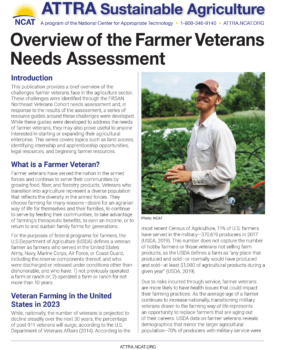Overview of the Farmer Veterans Needs Assessment
By Laura Biasillo and Mimi Thomas-Brooker, FRSAN Veterans Cohort
Introduction
This publication provides a brief overview of the challenges farmer veterans face in the agriculture sector. These challenges were identified through the FRSAN Northeast Veterans Cohort needs assessment and, in response to the results of the assessment, a series of resource guides around these challenges were developed. While these guides were developed to address the needs of farmer veterans, they may also prove useful to anyone interested in starting or expanding their agricultural enterprise. This series covers topics such as land access, identifying internship and apprenticeship opportunities, legal resources, and beginning farmer resources.
What is a Farmer Veteran?
Farmer veterans have served the nation in the armed forces and continue to serve their communities by growing food, fiber, and forestry products. Veterans who transition into agriculture represent a diverse population that reflects the diversity in the armed forces. They choose farming for many reasons—desire for an agrarian way of life for themselves and their families, to continue to serve by feeding their communities, to take advantage of farming’s therapeutic benefits, to earn an income, or to return to and sustain family farms for generations.
For the purposes of federal programs for farmers, the U.S Department of Agriculture (USDA) defines a veteran farmer as farmers who served in the United States Army, Navy, Marine Corps, Air Force, or Coast Guard, including the reserve components thereof, and who were discharged or released under conditions other than dishonorable, and who have: 1) not previously operated a farm or ranch or; 2) operated a farm or ranch for not more than 10 years.
Veteran Farming in the United States in 2023
While, nationally, the number of veterans is projected to decline steadily over the next 30 years, the percentage of post-911 veterans will surge, according to the U.S. Department of Veterans Affairs (2014). According to the most recent Census of Agriculture, 11% of U.S. farmers have served in the military—370,619 producers in 2017 (USDA, 2019). This number does not capture the number of hobby farmers or those veterans not selling farm products, as the USDA defines a farm as “any place that produced and sold—or normally would have produced and sold—at least $1,000 of agricultural products during a given year” (USDA, 2019).
Due to risks incurred through service, farmer veterans are more likely to have health issues that could impact their farming practices. As the average age of a farmer continues to increase nationally, transitioning military Veterans drawn to the farming way of life represents an opportunity to replace farmers that are aging out of their careers. USDA data on farmer veterans reveals demographics that mirror the larger agricultural population—70% of producers with military service were 65 years of age or older. Farms operated by producers with military service accounted for more than 129 million acres of farmland, the majority of which (74%) were less than 180 acres in size.
Farm and Ranch Stress Assistance Network – Northeast Region Farmer Veteran Needs Assessment
In the fall and winter of 2021, the Veteran’s Cohort (VETCO), a sub-organization of the Farm and Ranch Stress Assistance Network-Northeast Region (FRSAN-NE), commissioned a farmer veteran needs assessment in partnership with the Bureau of Sociological Research at University of Nebraska. The intent was to provide VETCO with insights into the needs facing today’s farmer veterans and help determine the resources most needed to assist them. The needs assessment was conducted online in conjunction with farmer veteran virtual focus groups to further tease out common topics of interest and areas of need for farmer veterans.
Needs Defined by the Study
Over 400 farmer veterans participated in the needs assessment. The highest-rated areas of interest for farmer veterans were:
- Conservation technical assistance/funding
- Farm diversification
- Sustainable agriculture
- Farm/ranch management, such as developing a crop plan
- Production-related needs for crops or livestock
Some of the highest-rated needs were in the areas of business planning and marketing support. These included:
- Business planning support and technical assistance
- Obtaining loans
- Business planning assistance
- Risk management
- Financial recordkeeping and tax planning
- Estate planning
- Marketing support and technical assistance
- Building a marketing plan
- Exploring new market channels
- Branding
- Pricing
The figures below show areas of interest of farmer veterans, as identified by the needs assessment, in several key categories.

Figure 1. Business/Financial Planning.

Figure 2. Marketing Strategies.

Figure 3. Legal Aid.
Conclusion
Each year, more military veterans transition to agriculture to provide for their families and serve their communities. While farming is a noble profession, it is not without risks. Having a plan and the resources for success are critical components of any agricultural operation. The guides produced for this project can serve as a starting point in this endeavor.
References
U.S. Department of Veterans Affairs. 2014. Projected Veteran Population 2013 to 2043. October 13.
U.S. Department of Agriculture (USDA). 2019. 2017 Census of Agriculture. April.
Overview of the Farmer Veterans Needs Assessment
By Laura Biasillo and Mimi Thomas-Brooker, FRSAN Veterans Cohort
Published May 2023 ©NCAT
IP645 • Slot 684
This publication is produced by the National Center for Appropriate Technology through the ATTRA Sustainable Agriculture program, under a cooperative agreement with USDA Rural Development. ATTRA.NCAT.ORG. This publication was also made possible in part by funding from the USDA’s National Institute of Food and Agriculture, Farm and Ranch Stress Assistance Network (FRSAN), projects 2019-70028-30464 and 2020-70028-32729.



